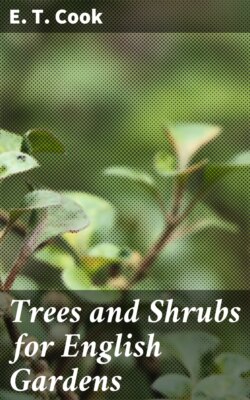Читать книгу Trees and Shrubs for English Gardens - E. T. Cook - Страница 31
На сайте Литреса книга снята с продажи.
Trees
ОглавлениеTable of Contents
First among these are the American Red Oaks. Undoubtedly the best of these is a variety of Quercus coccinea known as splendens and grayana. This not only turns to a fine scarlet crimson, but it retains its foliage for some weeks after the colour has been acquired—sometimes almost up to Christmas. Other good Oaks, not so certain, however, as the preceding, are Quercus marylandica (or nigra), Q. heterophylla, Q. imbricaria, and Q. palustris, all of which turn red. The Tupelo tree (Nyssa sylvatica) turns a fine burnished bronzy red. A tree remarkable for the size of its leaves, and especially for the rich golden yellow they put on in autumn, is Carya tomentosa, but, like most of the Hickories, it is scarcely known in gardens. Carya sulcata is somewhat similar. The Common Elm is usually very beautiful in the soft yellow tints of its leaves in autumn, but another Elm of more distinct aspect is Ulmus pumila, a low tree whose small leaves are retained till late in the year, and turn golden yellow before they fall. Liquidambar styraciflua has long been valued for its fading foliage of purple red, but not so well known is the lovely yellow of the Fern-like foliage of the Honey Locust (Gleditschia triacanthos). The Tulip tree (Liriodendron), the Nettle trees (Celtis), the Zelkowas, and several of the Birches turn yellow, one of the best of the Birches being Betula corylifolia, which turns a rich orange yellow.
Among commoner trees the yellow of the Horse Chestnut, the lovely crimson of the Wild Cherry, the golden shades of the Black and Lombardy Poplars, add much to the beauty of every autumn. Several of the Maples are noteworthy in this respect, more especially the numerous varieties of Japanese Maples (Acer palmatum and A. japonicum), these, as well as the Mandshurian Acer Ginnala, turning to various shades of red. The Common Sycamore and Norway Maple change to yellow, but Schwedler's variety of the latter becomes red. Other trees that deserve mention are Amelanchier canadensis, whose foliage changes to lovely crimson shades in autumn; Kœlreuteria japonica, soft yellow; Pyrus torminalis, bronzy red; Ginkgo biloba, pale gold; Cladrastis tinctoria, yellow; Parrotia persica and Hamamelis, bronzy red and yellow. The Common Beech is nearly always beautiful, changing first to yellow, then to warm brown tints. Clerodendron trichotomum is a small growing tree that should have a place wherever beautiful autumn foliage is desired. Among Conifers the yellow-leaved variety (aurea) of the Scotch Pine is remarkable in retaining its colour during the winter months only, becoming green in spring and summer. Retinospora squarrosa and Cryptomeria elegans turn bronzy red in winter. The warm red-brown tints of the deciduous Cypress are charming.
